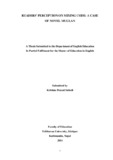Please use this identifier to cite or link to this item:
https://elibrary.tucl.edu.np/handle/123456789/1800| Title: | Readers' Perceptionon Mixing Code: A Caseof Novel Muglan |
| Authors: | Subedi, Krishna Prasad |
| Keywords: | Imperialism;Hybridization;Bilingualism |
| Issue Date: | 2014 |
| Publisher: | Faculty of Education |
| Abstract: | Thepresent study entitled "Readers' perception on mixing code: A case ofnovel Muglan" aimedto find out the readers' perception on why thecodes are mixed up and to identify the mixed codes either assimilated orunassimilated in Nepali language in the novel Muglan. In order to carryout this study, twentyNepali literary figureswho had already gonethrough the novelas well as the author of the novel Muglan were sampledpurposively.The main tool of the research was a set of questionnaires.which consisted of both open-ended and closed ended items. Theresponses of the informants were collected and the data were analyzed tofind out their perceptions on those mixed codes of the novel. The majorfindings of the study were that in most of the pages the author has mixedcodes and the readers perceived them as the common trend of presentliterary writing. What they perceived is that most of the mixed codes areloan words which cannot be avoided and some others have contextualreality as the novel is based on foreign affair. The study is divided into five main chapters. Chapter one deals withintroduction. It consists of general background, statement of the problem,rationale of the study, objectives of the study, research questions,significance of the study, delimitations of the study and operationaldefinitions of the key terms. The second chapter is about the review ofrelated literature. It consists of the review of empirical literature,implications of the review for the study, review of theoretical literatureand conceptual framework. The third chapter includes methods andprocures of the study. It consists of the design of the study, populationand sample, sampling procedures, tools of data collection, data collectionprocedure and the data analysis and interpretation procedures. Chapterfour incorporates the results and discussion of the collected data. This 9 chapterincludes two parts: the former deals with the results drawn fromthe analysis of data and the later deals with the discussion of those resultsin detail. The final chapter presents the summary, conclusions andimplication of the study at different levels of application. The study endswith the list of references and appendix |
| URI: | http://elibrary.tucl.edu.np/handle/123456789/1800 |
| Appears in Collections: | English Language Education |
Files in This Item:
| File | Description | Size | Format | |
|---|---|---|---|---|
| THESIS.pdf | 239.34 kB | Adobe PDF |  View/Open |
Items in DSpace are protected by copyright, with all rights reserved, unless otherwise indicated.
